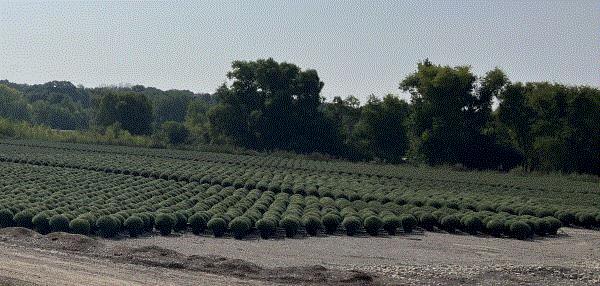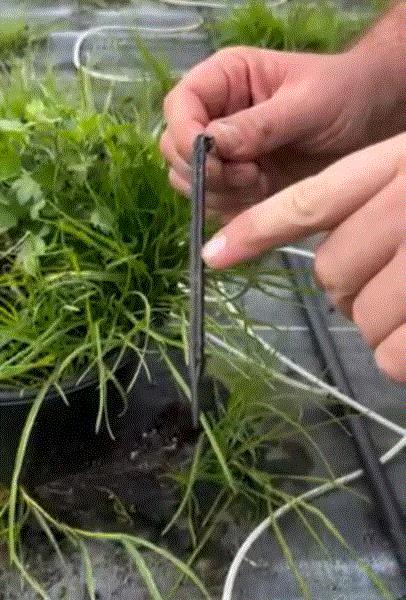Late-Season Garden Mum Pest and Disease Control
Mums have been on the shelves at my local retailers for weeks now. There isn’t really “fall color” in the Carolinas’ Low Country, so to me the appearance of mums is a more noticeable sign of the approaching fall.
I have to say, pest pressure on garden mums grown in the field is always much lower than pot mums in greenhouses. Why? I'm not sure. It may have to do with the field environment being less conducive to pest and disease outbreaks. Also, it could be that natural enemies readily move in from the surrounding fields and kill off the pests before they have a chance to raise their ugly heads.
Two pests that I’ve seen pop up with some regularity in field mums are aphids and caterpillars. Neither are too difficult to control. Y’all can still get good control of aphids with chemigation of neonicotinoids or other systemic insecticides if you have a couple of weeks to spare. If you're closer to shipping, then I’ll move in with a spray of insecticides, such as one of the neonicotinoids, pyrifluquinazon (Altus), pymetrozine (Endeavor) and afidopyropen (Ventigra). Make sure you achieve thorough coverage of the underside of leaves, where the majority of the aphids live.

The insecticides you use for aphids will have no or poor efficacy for caterpillars. Caterpillars are controlled effectively with carbaryl and pyrethroids. You can also spray abamectin (such as Avid), spinosad (such as Conserve), chlorantraniliprole (Acelepryn) or tolfenpyrad (Hachi-Hachi). All these insecticides knock out the caterpillars in only a few days.
You may see some oddball pests, such as thrips, beetles, leafhoppers or tarnish plant bugs from time to time. (Let me know if you see them—I have good ways of killing them.)
Hopefully, you’ve done a pretty good job of managing Pythium and Fusarium wilt throughout production. Prevention of diseases is so much more effective than trying to suppress or mask their symptoms before shipping. If these diseases show up before you need to ship, I certainly wouldn’t ship the symptomatic plants and plants closest to (or down the water runoff path from) them because they’ll look quite horrible when they arrive at the retailers. Think about the hit to your reputation!
For plants that haven’t shown any symptoms and far from the symptomatic plants, you may consider drenching with a fungicide that had worked well for you in the past or recommended by your favorite plant pathologists. I might go with cyazofamid (Segway), etridiazole (Terrazole), mefenoxam (Subdue Maxx) and boscalid + pyraclostrobin (Pageant Intrinsic) for Pythium. Fusarium is a bit tougher to deal with—I might go with azoxystrobin (Heritage), fludioxonil (Medallion) and triflumizole (Terraguard).
I wrote about pest management in greenhouse mum production in the past. Go HERE for a piece on pest management in general mum production, which has information appliable to field production as well. Go HERE for a piece on late-season greenhouse mum pest management.

Herbicide Calibration Resources
Y’all know weed management in container nurseries is costly. Without any management, a block can be quickly overrun by weeds, especially species that germinate, grow and seed within weeks, such as spurge.
Frequent hand weeding can be very effective in reducing weeds, but many folks don’t want to hand weed on a regular basis because of a shortage of labor and the high cost of labor. But, as shown by a study by Joe Neal of North Carolina State University, hand weeding every two weeks is more effective (74% weed reduction) and cost efficient (reducing labor cost by 36%) than hand weeding every eight weeks. So frequent hand weeding is definitely worth the time and cost.
Most operations employ the approach of preemergent herbicide applications combine with hand weeding. In addition to selecting the right herbicide (considering weed spectrum, crop safety, mode of action, etc.), calibration of sprayers or belly-grinders is very important in achieving uniformity in application. Preemergent herbicides only prevent weed germination or growth in areas where the herbicides contact. Poor uniformity of coverage will create untreated areas or areas with low doses of herbicide where the seeds can germinate.

A block of peonies overran by spurge.
Envu released a seven-minute video on how to calibrate your backpack sprayer and granular spreader a couple of weeks ago. I think the video is very well done, with easy-to-follow step-by-step instructions on how to measure out calibration areas, make the application and calculate the final application amount. You can easily calibrate your application equipment by following the instructions. Go HERE for the video.
If you’re super old school and want some printed materials on hand, go HERE for a detailed fact sheet on calibrating sprayers. The author, Mark Holcomb of the University of Tennessee, has been retired for, oh, 12 years now. But what Mark wrote is still applicable today.
Envu’s calibration only touches on backpack sprayers and belly-grinders; you can learn how to calibrate a boom sprayer using the one-minute method by going HERE and using the 1/128th method by going HERE.
Do you need to calibrate sprayers on drones? Well, you’ll have to consult the Nozzle Guy (Tom Wolf of Agrimetrix Research and Training) and the Spray Guy (Jason Deveau of the Ontario Ministry of Agriculture, Food & Agribusiness) on Sprayers 101. Go HERE for their article, which is pictorial and informative. They also have a series of videos, which are pretty fun to watch.
Although much of the resources mentioned here are for herbicides, the same principles are also applicable to sprayers and spreaders that are used for plant growth regulators, fungicides and insecticide applications. You'll find them all very helpful.

So … How Do You Kill Weed Seeds on a Stake?
Here's an intersection between mums and weeds. I received an interesting question yesterday: How do you kill weed seeds on drip tube stakes so that you don’t reintroduce them into the pots (mums in this case)?
Well, I’m stumped.
It’s not the first time I’d been asked this question, but the conversation often ends with the grower admitting (without my shaming and bullying) not doing a good enough job of managing weeds and giving the weeds a chance to seed and stick to the stakes. They’ll do better next year.
Sure, that kind of self-examination saves me the trouble of having to pretend to be a knowledgeable weed scientist (instead of an entomologist trying hard to learn weed management). But that doesn’t seem good enough for me. I need an answer.

So I texted my boss Kyle Briscoe of SePRO who’s a bona fide weed scientist and asked him what in the world a person can do to kill weed seeds when the seeds are still on the stakes. Even Kyle wasn’t sure. Maybe soaking the stakes in bleach, vinegar, hydrogen peroxide or quaternary ammonium solution? We aren’t sure because we don’t know any data to gauge the efficacy of the approach. What we are sure of is this: There isn’t any preemergence or post-emergence herbicide registered for use in that manner, i.e., soaking to kill seeds. No matter what you use it seems to be that spraying or dipping stakes for a short time won’t break through the tough seed coat to kill the embryo inside. And how long do you need to soak? I don’t know.
Maybe you can kill the seeds by heat through solarization, heating or soaking in hot water. How long do you need to keep the stakes heated? Can the plastic stakes stand the heat? I don’t know!
Do you have a good solution for this question? Email me and let me know!

PSU Biocontrol School
If you're in southeastern Pennsylvania (or are willing to drive) and want to learn more about biological control, here's a training opportunity for you.
Penn State Extension will hold an in-person Biocontrol School for anyone interested in learning about biological control and sustainable pest management. Date of the training is December 5, 2024, starting at 8:30 a.m. Eastern. The full-day event will be held at the Farm and Home Center in Lancaster, Pennsylvania.

Speakers from Penn State Extension, BioWorks, Certis, IPM Labs and Koppert will introduce attendees to various groups of biological control agents (beneficial insects, fungi, etc.). The workshop features a great lineup of speakers who'll give good background information and advice on implementing biological controls.
Go HERE to find details about the Biocontrol School, such as registration, agenda, continuing education credit (CEU) information and more. The registration fee is $85 and the registration deadline is November 30.





See y'all later!

JC Chong
Technical Development Manager at SePRO
Adjunct Professor at Clemson University
This e-mail received by 27,847 subscribers like you!
If you're interested in advertising on PestTalks contact Kim Brown ASAP!